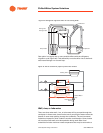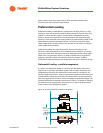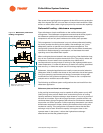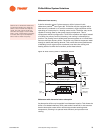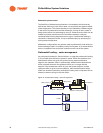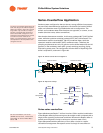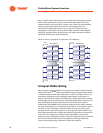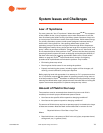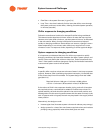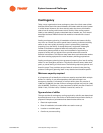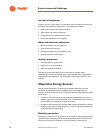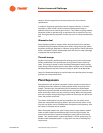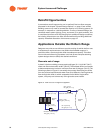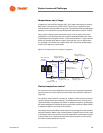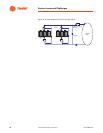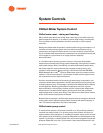
80 Chiller System Design and Control SYS-APM001-EN
System Issues and Challenges
• Flow Rate = the system flow rate, in gpm [L/s]
• Loop Time = the time it takes for fluid to leave the chiller, move through
the system, and return to the chiller, allowing for stable system operation,
in minutes [seconds]
Chiller response to changing conditions
Follow the manufacturer’s advice for the specific chiller being considered.
This determines the absolute minimum amount of water the loop requires.
However, this is the chiller minimum, not the system minimum, as discussed
in the next section. Many of today’s chillers have controls that respond
quickly to changing conditions. Some chillers can react to a change in return
water temperature in one minute; other chillers may require five or more
minutes to react. The response varies, depending on chiller type and design.
System response to changing conditions
It is important to understand that even if a chiller can respond to rapidly
changing conditions, the interaction between the chiller, system pumps, and
control valves may define the minimum loop time. These components may
“hunt” if the system conditions change too rapidly. Review these interactions
to ensure that system control will be stable.
Example
A specific chiller requires at least two minutes of water in the loop to operate
properly. However, after considering the system interaction, it’s decided that
a five-minute loop time will work best. The system design flow rate is 960
gpm [60.6 L/s].
Required Volume = 960 gpm × 5 minutes = 4,800 gallons
= 60 L/s × 5 minutes × (60 seconds/1 minute)= 18,180 liters
If the volume of fluid in the evaporator bundle, piping, and coils is less than
the required volume, a tank should be added to increase loop volume. For
optimal stability, the tank should be placed in the return water position and
be designed to mix the returning-water stream with the water currently in the
tank. In systems with no bypass, the tank may be placed in the supply chilled-
water position.
Alternatively, the designer could:
• increase pipe sizes (increases system volume and reduces pump energy)
• design system for a lower flow rate (lowers required volume and reduces
pumping energy, especially when same-sized pipes are used)



